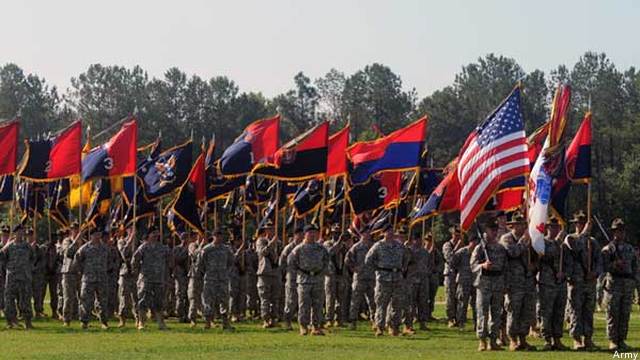Army Juggles Drawdown; Plans For Future Growth
Posted on

The Department of Defense is on the defensive nowadays, with everybody braced for cuts. The Army already has marching orders to reduce its manpower from the current 565,000 active-duty personnel to 520,000, and no one expects it to stop there.
But some Army leaders are looking past the lean years and planning how to build back up again in a hurry if they have to. Their message to budgeteers: We understand you’re going to cut us, but do it carefully so we keep what we’ll need to regenerate in a future crisis – a concept that’s being called the “expansible Army.”
The idea will take some selling. The nation’s combat forces have officially left Iraq, a drawdown in Afghanistan is in sight, and the Army is selling itself in terms of low-cost, low-manpower, low-casualty missions like “building partnership capacity” in allied countries. It sort of spoils the party to warn that we might end up in another big ground war someday whether we like it or not. And some of the recommendations about how to hedge against that ugly eventuality are “counterintuitive,” admitted Lt. Gen. Keith Walker, deputy commander in charge of “futures” at the Army’s Training and Doctrine Command.
Speaking to reporters at the most recent of a series of events on the Army of 2020, Walker said that in past downsizings the Army has tried to preserve as many combat units as possible by cutting support functions seen as institutional overhead, but that can be a false economy.
“If a crisis occurs and the nation needs you to grow,” he said, “your capacity to grow is not there… I’m talking about the folks that man, train, and equip the Army.” So instead of slicing the Army’s recruitment, training, and procurement organizations – the so-called “generating force” – to the bare minimum needed to support a downsized fighting force, Walker concluded, “the generating force would have to have some extra capacity” in order to could quickly stand up new forces in a crisis.
There is some institutional self-interest at work here: Walker’s own Training and Doctrine Command (TRADOC) is one of those overhead functions that historically gets cut first. That doesn’t mean he doesn’t have a point. The Army does have an unhappy history of eating its intellectual seed corn in hard times. In the period between World War I and World War II, an obsession with keeping the maximum number of soldiers possible on a constrained budget led the service to sacrifice investment in newfangled technologies like tanks and airplanes. More recently, in 2004, the Army stripped the National Training Center of its elite “opposing force” (OPFOR) unit that simulated enemy forces and sent them en masse to Iraq, replacing them with less expert trainers for soldiers to hone their skills against.
The “expansible Army” idea isn’t just a “don’t cut me” plea, either. The Army is also exploring new ways to get much-needed flexibility into its historically sclerotic personnel system so it can encourage its experienced but bone-weary combat veterans to stay in uniform. “It’s an ideal time to change,” said Lt. Gen. Thomas Bostick, the Army’s deputy chief of staff for personnel (aka “G-1”), during a presentation at the annual conference of the Association of the United States Army. “As we start drawing down our army, we’ve got these great noncommissioned officers and officers who’ve been in the fight for ten years. They’re not going to be excited about going back into garrison life [at some base in the U.S.]. We’ve got to keep them motivated, we’ve got to keep them in the military.”
So Bostick and other Army leaders are looking at a host of ways to make the terms of service more flexible and accommodating. One pilot project is an internal “Green Pages” job board to help hook officers up with assignments they actually want – instead of the personnel bureaucracy sending, say, an Arab language expert to Korea. Another idea is to send more officers on “broadening” assignments such as working in private industry or studying at civilian graduate schools, a few years off from repeated deployments to take a breather and learn new skills.
Perhaps the most sweeping proposal is a “continuum of service” concept to better connect the active-duty force and the reserves. “The idea of this continuum is that people can move back and forth,” either to accommodate their personal needs – a few years off from regular deployments to focus on the kids, for example – or “when we as a military need them to,” said Lt. Gen. Jack Stultz, commander of the Army Reserve, in a conference call with journalists. Historically, Reserve and National Guard units trained one weekend a month plus two weeks in summer so they were ready to be called up in a national crisis, but the Army has already gone to that well over the past ten years. So Stultz and other officers are looking at what amounts to a reserve for the reserve, an “inactive reserve” whose members retain an association with the military but who are not subject to deployments. The idea is essentially a vast holding pool for combat-proven military talent in case the Army needs it again in a hurry.
“We’re going to have to reduce the size of our active military,” said Stultz. “What we’ve got to figure out is how we preserve that human capital, how we preserve that experience, so we don’t have to regenerate every time we have another [crisis]. You can’t grow Sergeants First Class overnight. You can’t grow a major overnight.” But if you keep the old battle-proven ones around, you may not have to.
Subscribe to our newsletter
Promotions, new products and sales. Directly to your inbox.
